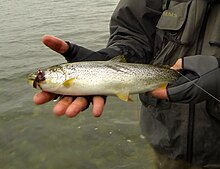
Back سمك السلمون المرقط الساحلي Arabic Oncorhynchus clarkii clarkii Catalan Oncorhynchus clarkii clarkii Spanish Oncorhynchus clarkii clarkii Dutch Oncorhynchus clarkii clarkii Portuguese
| Coastal cutthroat trout | |
|---|---|

| |
| Scientific classification | |
| Domain: | Eukaryota |
| Kingdom: | Animalia |
| Phylum: | Chordata |
| Class: | Actinopterygii |
| Order: | Salmoniformes |
| Family: | Salmonidae |
| Genus: | Oncorhynchus |
| Species: | |
| Subspecies: | O. c. clarkii
|
| Trinomial name | |
| Oncorhynchus clarkii clarkii (Richardson, 1836)[2]
| |
The coastal cutthroat trout (Oncorhynchus clarkii clarkii), also known as the sea-run cutthroat trout, blue-back trout or harvest trout, is one of the several subspecies of cutthroat trout found in Western North America. The coastal cutthroat trout occurs in four distinct forms. A semi-anadromous or sea-run form is the most well known. Freshwater forms occur in both large and small rivers and streams and lake environments. The native range of the coastal cutthroat trout extends south from the southern coastline of the Kenai Peninsula in Alaska to the Eel River in Northern California. Coastal cutthroat trout are resident in tributary streams and rivers of the Pacific basin and are rarely found more than 100 miles (160 km) from the ocean.
Adults migrate from the ocean to spawn in fresh water. Juveniles migrate to the sea where they feed and become sexually mature before returning to fresh water to overwinter and spawn. Unlike steelhead and Pacific salmon, coastal cutthroat do not make lengthy migrations out to sea. Generally speaking, coastal cutthroat will remain in or near estuarine waters, usually within 5–10 miles (8.0–16.1 km) of their natal stream. Some cutthroat, however, have been shown to move as far as 70 miles (110 km) into the open ocean. There are also lacustrine and riverine populations that spend their entire lives in freshwater. One such population is the trout of Lake Crescent in Washington state that was formerly considered to be a separate subspecies called the Lake Crescent cutthroat trout, Oncorhynchus clarkii crescenti.
- ^ NatureServe (4 August 2023). "Oncorhynchus clarkii clarkii". NatureServe Network Biodiversity Location Data accessed through NatureServe Explorer. Arlington, Virginia: NatureServe. Retrieved 20 August 2023.
- ^ Richardson, John; Swainson, William; Kirby, William (1836), Fauna boreali-americana, or, The zoology of the northern parts of British America: containing descriptions of the objects of natural history collected on the late northern land expedition, under command of Captain Sir John Franklin, R.N., London: J. Murray, pp. 225–226
